Sid Meier's Alpha Centauri - Gaia's Stepdaughters
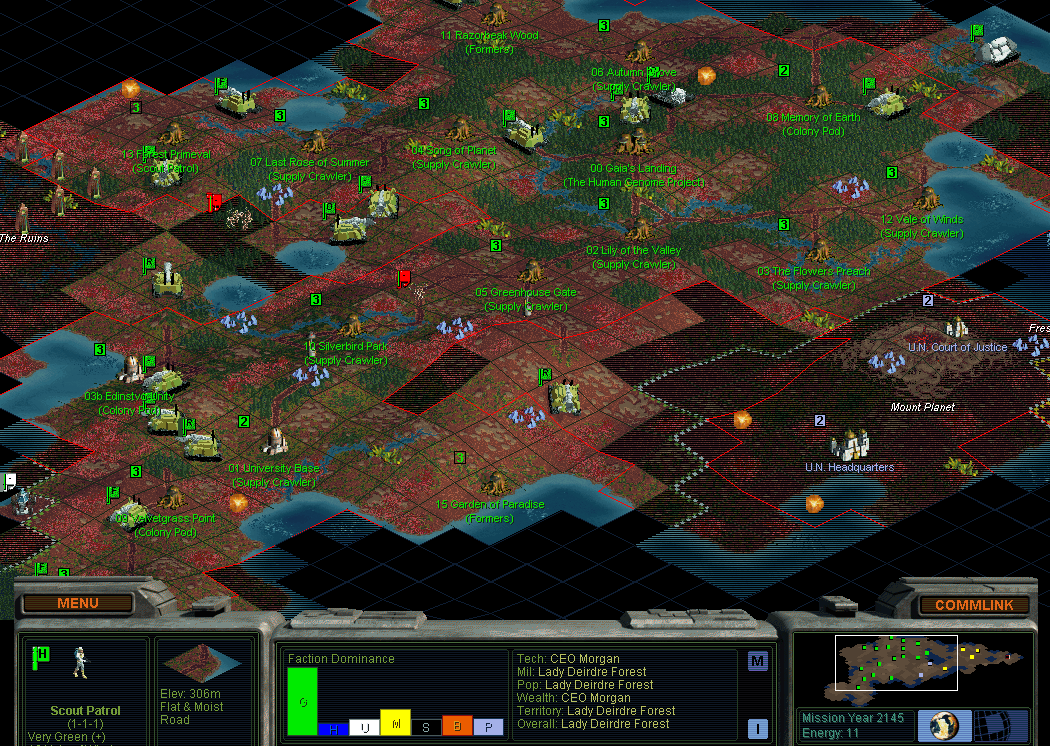
Like in the Morgan game, I would make heavy use of the Planetary Transit System secret project, which boosts to size 3 all bases both old and new. I completed it by cashing in eight supply crawlers, in year 2142, three turns slower than had Morgan. I had scheduled my build orders on the turn before the PTS to complete colony pods from each base that was then at size 2, so that it would drop to size 1 before being bounced back up to 3 for free. Those pods traveled outwards to the next few base sites shown here.
From here, I would build more colony pods gradually and judiciously. Unlike the Morgan game, I didn't see need for full-blown ICS here (much less lucrative without Free Market plus Wealth), and also didn't have the economy for every new base to immediately rush another pod like Morgan had. And I expected to be able to pop-boom to a considerably higher ceiling than had Morgan, so I built my bases with more room to grow. I continued to build a few pods from cities that had accumulated enough food to regrow from size 2 to 3, and in locations where my formers had built roads and sensors out to new base sites.
The one thing that went wrong with the PTS, same as with Morgan, was drone management. Both games continued to need 30% or 40% psych slider for some time after the PTS, even after following it with the Human Genome Project as soon as I could. Without Free Market, Gaia could do a bit better with a police unit in each base, but also had that much less raw economy to put into the psych slider and labs. An option might have been Police State for more police units; Gaia is secretly good at running that (the only faction besides Hive who can run Police + Planned without paralytic inefficiency), but that would go away once we needed Democratic for pop-booming. I probably should have simply built recreation commons, though the problem with that approach is that new bases can't complete that right away so would riot or starve.
I continued along with the bases all at size 3 for a while. Of course I wanted to pop-boom, but I already couldn't really manage the drones at size 3, so never mind going higher yet. Along the way, I kept reloading every turn roll to get a bunch of forest spreads, now getting three on most turns and as many as six a couple times.
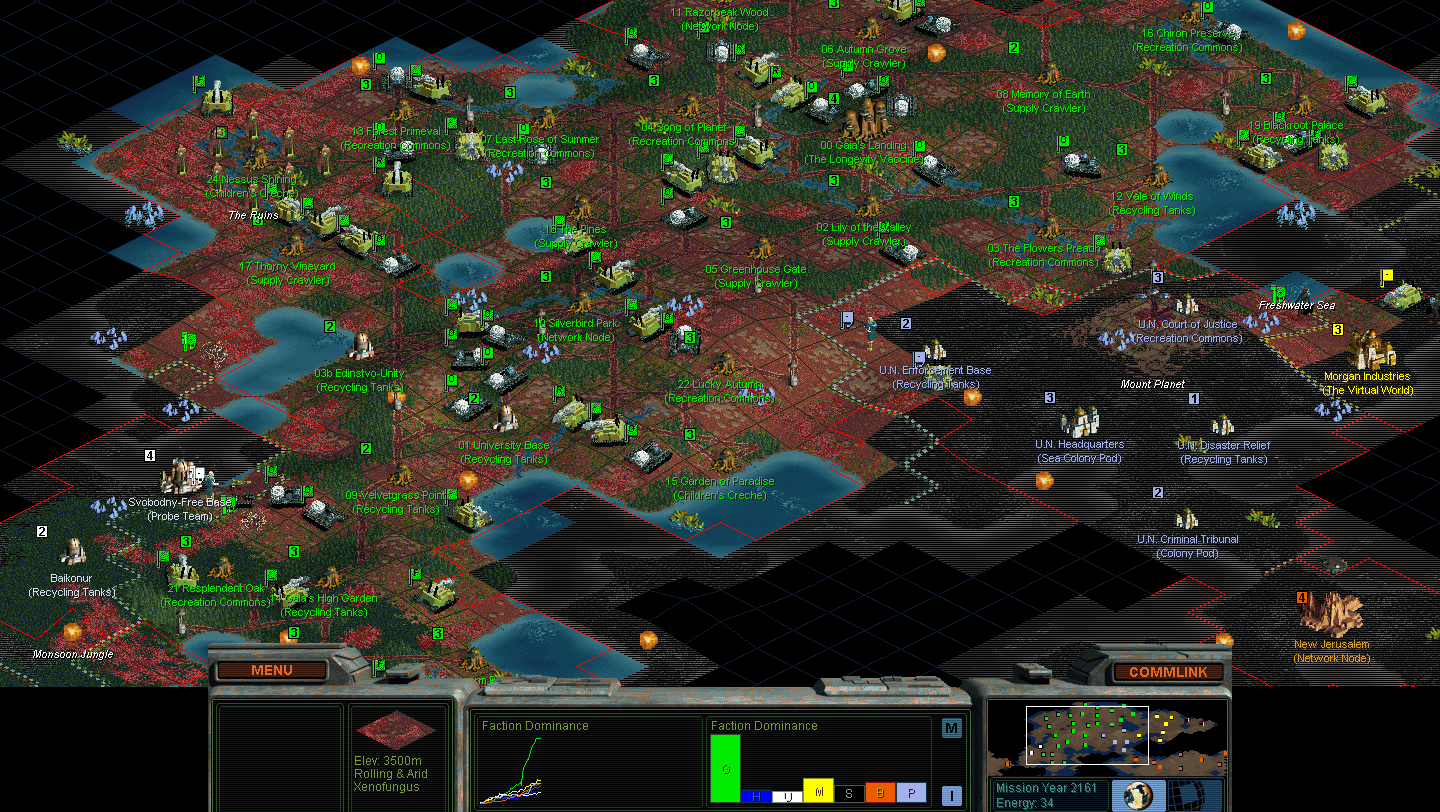
My answer would be found in the same tech path as in the Morgan game, Bio-Engineering, but for a different reason. The Longevity Vaccine secret project quells two drones in each base while your economics are Planned. In Free Market, it just gives +50% economy in its base, which is a tiny modifier and so Morgan skipped it. Research up to Bio-Engineering took 15 turns after the PTS. That beeline involved twice dodging missing-tech potholes, but fortunately Sparta gave me timely trades each time (Doc Mob and Doc Flex) to perturb the modulus.
Longevity Vaccine was my gateway to population-booming here. While researching up to it, I prepared my cities for the boom, by building the children's creches, more supply crawlers (fourteen of them to complete Longevity plus Weather Paradigm), and recycling tanks where food was still lacking. All that stuff completed noticeably faster thanks to not supporting scads of formers, thanks to getting all the forests from the rigged auto-spreading. So in 2161 as I was about to complete Longevity, I adopted Democratic politics and here we go.
Gaia is secretly the best faction at population-booming. Despite their stated agenda of strictly controlled population growth, they are the only faction that stays in a pop-booming configuration for a sustainable long term. Everyone who can usefully run Free Market wants to get back into that instead of Planned, and anyone who uses a Golden Age for booming wants to drop that too. With every other faction, I find myself trying to scramble and rush the pop-boom so I can get back to the configuration that I really want, at the cost of working net-negative tiles or doctor specialists until the terraforming catches up.
Only Gaia can run Democratic and stay in Planned, by compensating for its inefficiency. Deirdre has the same effect as Morgan, where mechanically they want to run a different economic choice than their supposed agenda. Their inherent faction abilities duplicate the strength of their agenda SE, so they're better off to rely on the inherency and use it to compensate for some other negative instead. Other factions experience this counterintuitive conflict too: Miriam's inherent attack bonus is enough to not need Fundamentalism's morale; University's inherent research is enough to postpone Knowledge for quite some time.

Besides the SE, Gaia also has one more major advantage for booming: the faction power for one extra nutrient from fungus tiles. That's huge. It turns fungus from junk into a perfectly serviceable supply of 2 food. But we'd still rather work forests -- so park supply crawlers on the fungus! Crawled fungus, not tree farms, is the best way to feed a population boom as Gaia. The crawler is 30 minerals to yield 2 food; the tree farm is 120 for roughly 8. Same ratio, but the time economy of crawlers is much better, incrementally every 30 minerals instead of waiting for all 120, and they're earlier in technology too. So this picture shows exactly how most bases were working their total of 14 food at the size-7 habitation limit: 7 worked forests, 3 from the base square including the recycling tanks, and 4 from two supply crawlers on fungus.
For drone control, on top of the Longevity Vaccine, I did indeed build rec commons as well. Then my tech path continued up to Intellectual Integrity, where I could upgrade each police unit to the double-police ability plus a clean reactor in one stroke for a single upgrade payment. And the next build in each base was its network node, which would be augmented by the Virtual World. All this together covered drones up to size 9 in each base without any psych slider, and beyond that would be specialists.
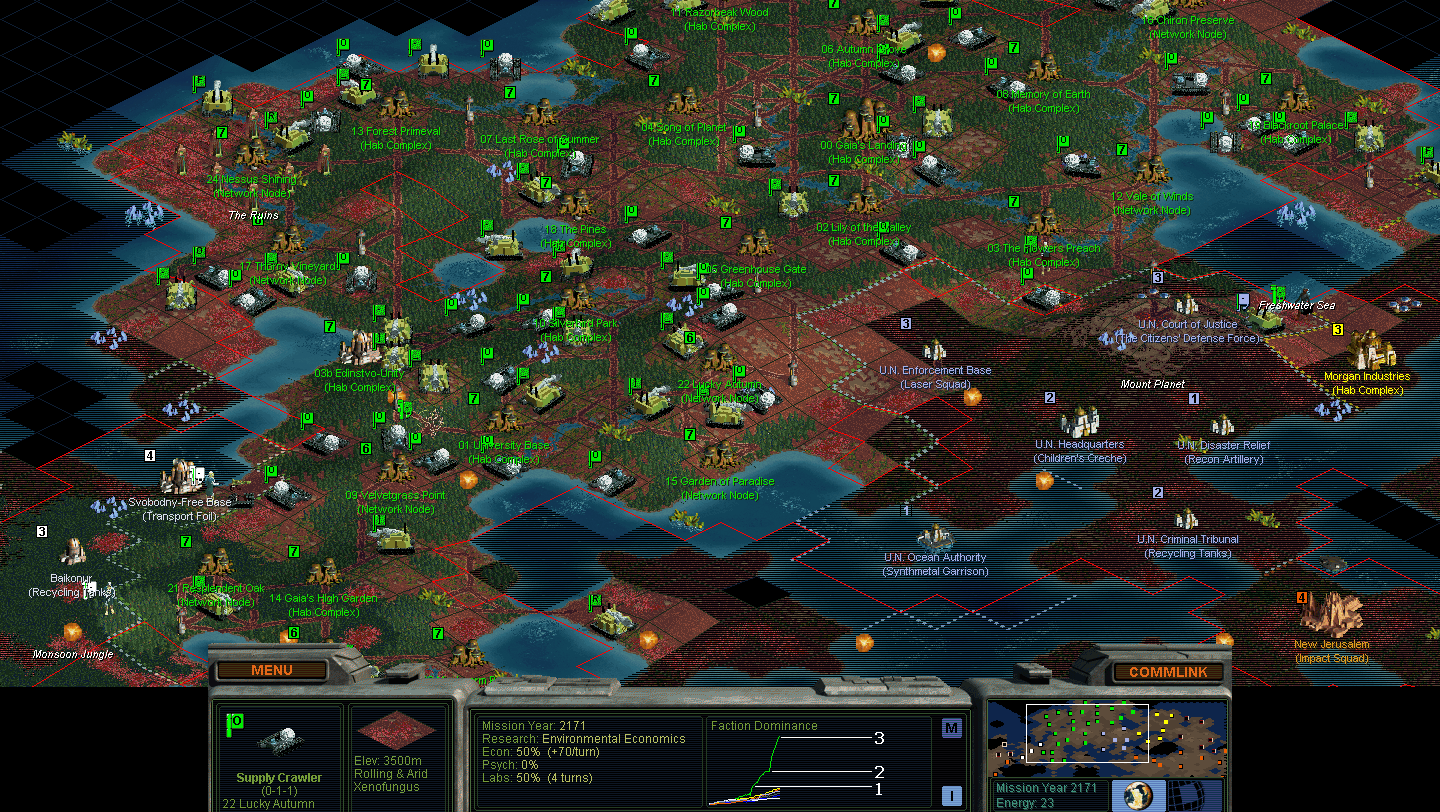
So overall, I was really satisfied about how Gaia could execute The Long Boom here. Booming requires the growth modifiers, food supply, worthwhile tiles to work, and drone control. For any base that was short on one of those factors at any moment, it could simply pause booming for that moment and resume when it was ready. The build order in each base went recycling tanks - children's creche - two supply crawlers for fungus - rec commons - network node - hab complex - tree farm.
I like the faction dominance graph in that picture. It clearly shows three distinct doublings as I marked: first the PTS itself doubled my population, then my count of bases doubled with colony pods, then the boom doubled my population again up to size 7 right now.
The bases now built hab complexes, while I finished research to Environmental Economics, the tech that enables tree farms. This is a little bit suboptimal overall: as I always say, hab complexes don't do anything until you have the food to boom to max size. Tree farms should come first because they do something in the meantime: the +50% economy, and also the food indirectly provides minerals by switching food crawlers to that instead. But my tech path just had so many other priorities that we didn't get around to Environmental Economics for quite some time, so the best way to fill that time was to build the hab complexes a bit sooner. The complexes would be idle for a few turns while we then also built the tree farms, but that's still the fastest path to getting them both up and running.
I think it was worth illustrating all this. "Forest-and-forget, rush to tree farms" is popular strategy advice for newcomers. That's OK, but I always caution that tree farms aren't the all-solving panacea that they seem to be perceived to be. They're strong, but only once a base has boomed to be working enough forests; before that, crawlers give better payback. 120 minerals is a lot, and to put everything together to use those tree farms does require all that terraforming and other infrastructure before you get there.
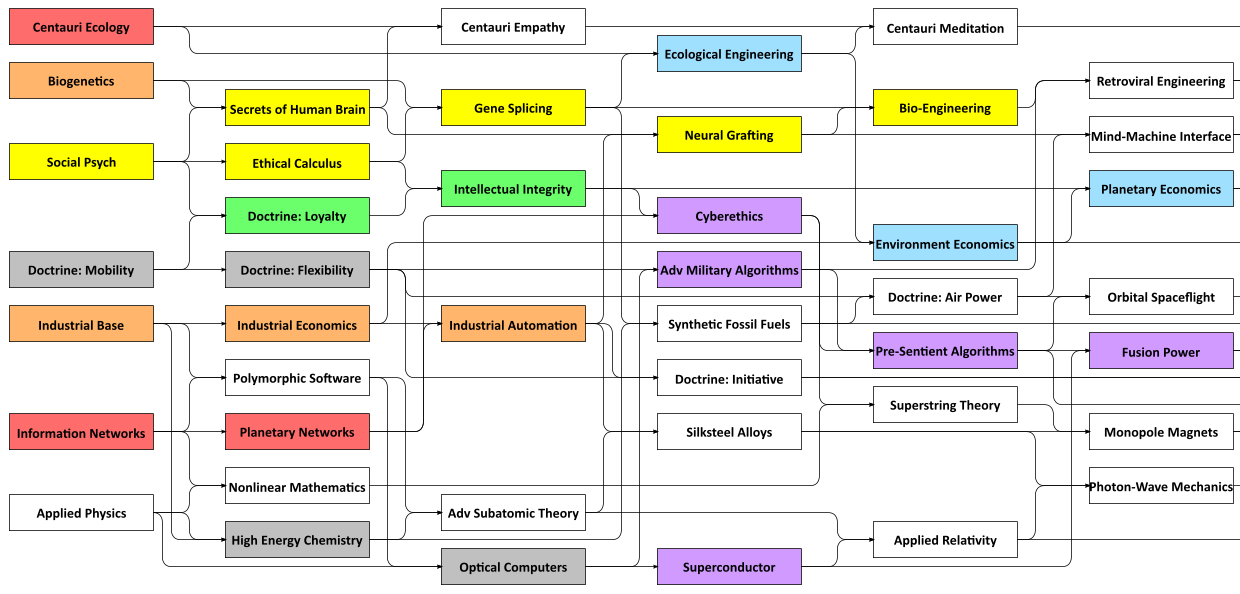
In fact, I'll illustrate my entire technological progress. Visualizing the entire tech tree is probably the biggest challenge for newcomers to SMAC. There is no in-game overview of the entire tree at all. There are many aftermarket depictions, but I find that pretty much every one of them becomes an unreadable mess thanks to how highly interconnected the graph is. This layout is my own attempt at making sense of it.
To follow my tech path, follow the rainbow through the beelines. The red boxes show my start up to Planned economics here. Orange to Industrial Automation for Wealth and crawlers and the PTS, yellow to Bio-Engineering for the Longevity Vaccine, green to Intellectual Integrity for police units, blue to tree farms, then violet up to Fusion Power. This shows all the most common beelines with reason to be worth doing in the earlier game.
Gray boxes are techs I picked up in trades. Nothing I needed immediately, but useful prerequisites for later. The one that is particularly notable is Optical Computers. The tech does literally nothing. But some AI always gets it early, since it and its prerequisite Polymorphic Software are always the highest Discover-weighted techs at this time, and the Discover-weighted factions (University, Peacekeepers) are good researchers. I seem to trade for or steal Optical Computers in almost every game, which becomes an important stepping stone of skipping several prerequisites on the way to Fusion Power.
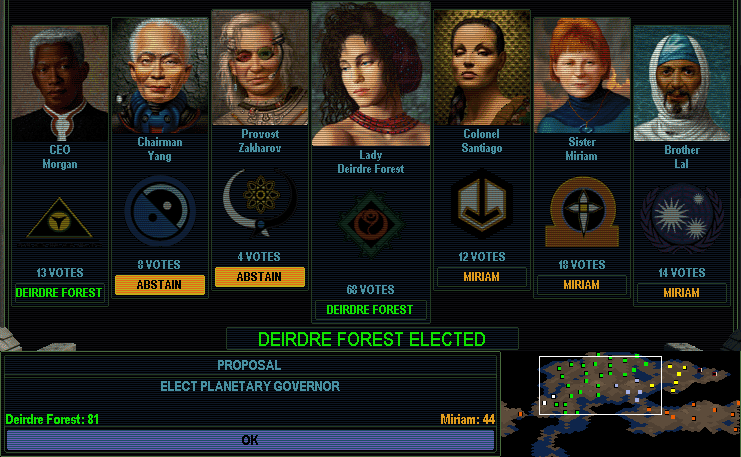
Speaking of the AIs, let's check in with them. It turned out that all seven factions were on the same continent that wrapped around the entire map. University, Peacekeepers, and Morgan neighbored me. Sparta was beyond Morgan, the Believers beyond the PKs, and Hive somewhere beyond the Believers. We all made contact pretty early, in year 2152, when Lal traded me Miriam's comm frequency and then Miriam traded me Hive's. I alertly sold a couple of those contacts around to my rivals right before calling the Council. And of course I won the governor election easily.

Just a few AI dealings worth noting. Governor infiltration showed Morgan with a huge pile of energy credits as always, so I paid off my original small loan balance so that he could be induced to offer a new loan, which I accepted here. Then Lal asked me for that cash for his Optical Computers; expensive but still cheaper than the beaker cost, so I took it. Then Lal turned half of that money right back around to me as a loan as well. The remaining money from those loans made a significant contribution towards getting my newest bases caught up on the infrastructure for booming.
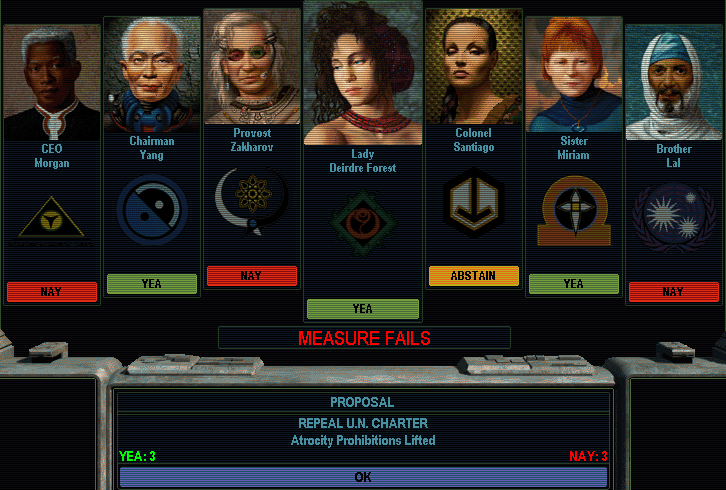
Alas, no easy nerve-stapling for drone control this time; my proposal to repeal the charter failed, and each of the nay votes either wouldn't speak to me or wanted thousands of credits.
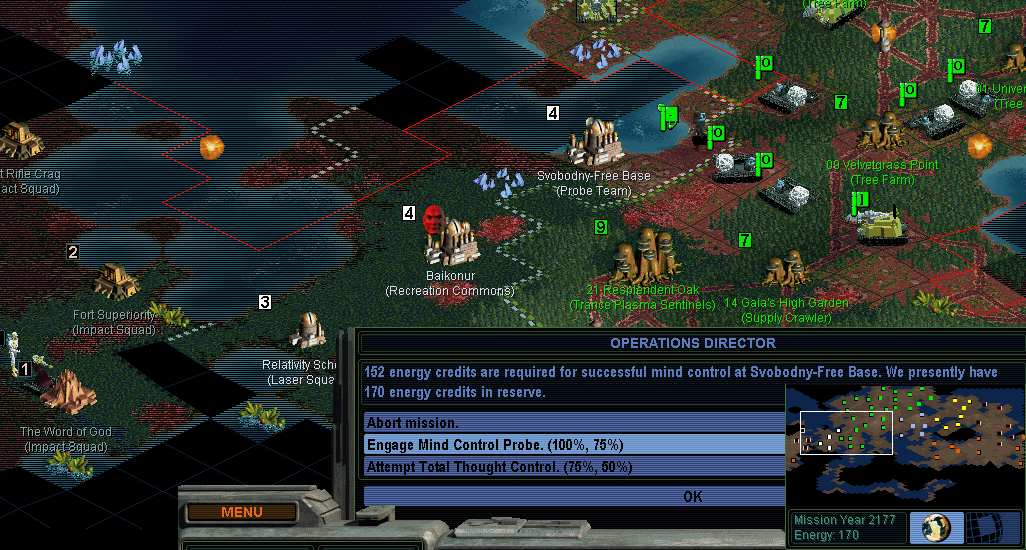
A while later, the University declared vendetta again. I bribed their first base with a probe - the faction still had no HQ, which makes everything count as a default large distance from it, so bribing was very cheap. This also happened to be just as I was researching Superconductor tech for gatling weapons, so I conquered the rest of the Uni bases with gatling rovers. (Not instantly as in the other games; there weren't roads between the bases, so this took about five turns total.)

Sparta had also declared vendetta, so I continued to capture those two closest Spartan bases as well. (Word of God was captured by Sparta from the Believers. Bunker 118 was captured by the Believers from Sparta.  ) That was enough damage to get Sparta to sign a truce. The Believers (beyond Sparta) also declared war too, until I captured Bunker 118 then gave it back for a truce.
) That was enough damage to get Sparta to sign a truce. The Believers (beyond Sparta) also declared war too, until I captured Bunker 118 then gave it back for a truce.
Now I controlled the whole jungle area, which was of course helpful in getting these bases boomed up to full size and productive. They never really quite caught up to my core bases, but did contribute positively. In the luck-abuse department, now on each turn roll I usually reloaded until getting at least one or two forest spreads in the jungle, since that was where I needed it most.
That was all the fighting that occurred in the game. My neighbors Morgan and the Peacekeepers were always wary, but I sensed the few times they were coming close to actually declaring war and paid their tech demands each time, so no vendettas ever broke out there.